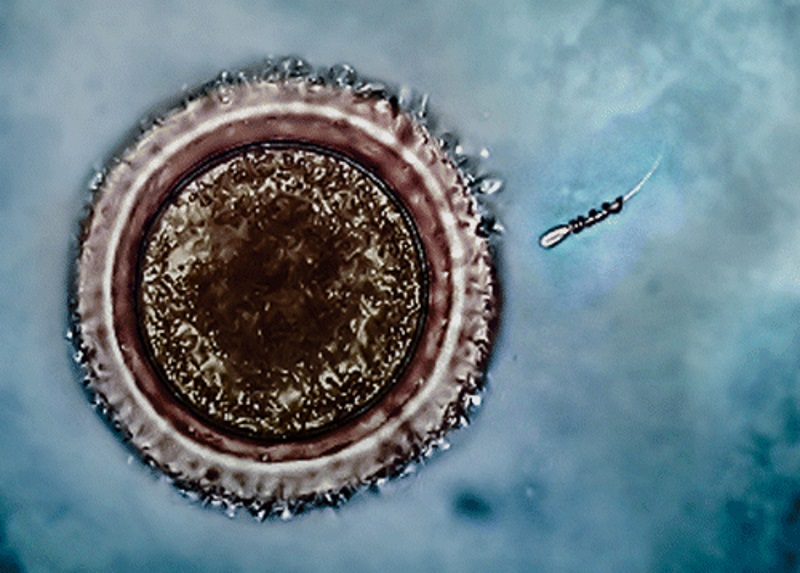- Home
- Science
- Science News
- 'Spermbots' Could Improve Fertility Treatments: Study
'Spermbots' Could Improve Fertility Treatments: Study

In the artificially motorised sperm cells, customised microhelices serve as motors for transporting sperm cells with motion deficiencies to help them carry out their natural function.
"Our results indicate that metal-coated polymer microhelices are suitable for this task due to potent, controllable, and non-harmful 3D motion behaviour," researchers said.
Sperm that do not swim well rank high among the main causes of infertility. To give these cells a boost, women trying to conceive can turn to artificial insemination or other assisted reproduction techniques, but success can be elusive.
Artificial insemination is a relatively inexpensive and simple technique that involves introducing sperm to a woman's uterus with a medical instrument.
Overall, the success rate is on average under 30 percent, according to the Human Fertilisation and Embryology Authority of the UK.
In vitro fertilisation can be more effective, but it is a complicated and expensive process. It requires removing eggs from a woman's ovaries with a needle, fertilising them outside the body and then transferring the embryos to her uterus or a surrogate's a few days later. Each step comes with a risk for failure.
Researchers from the Institute for Integrative Nanosciences at IFW Dresden in Germany wanted to see if they could come up with a better option than the existing methods.
Building on previous work on micromotors, the researchers constructed tiny metal helices just large enough to fit around the tail of a sperm. Their movements can be controlled by a rotating magnetic field.
Lab testing showed that the motors can be directed to slip around a sperm cell, drive it to an egg for potential fertilisation and then release it.
The researchers say that although much more work needs to be done before their technique can reach clinical testing, the success of their initial demonstration is a promising start.
"Our results indicate that metal-coated polymer microhelices are suitable for this task due to potent, controllable, and non-harmful 3D motion behaviour," researchers wrote in the study published in the journal Nano Letters.
"We manage to capture, transport, and release single immotile live sperm cells in fluidic channels that allow mimicking physiological conditions," they wrote.
Catch the latest from the Consumer Electronics Show on Gadgets 360, at our CES 2026 hub.
Related Stories
- Samsung Galaxy Unpacked 2025
- ChatGPT
- Redmi Note 14 Pro+
- iPhone 16
- Apple Vision Pro
- Oneplus 12
- OnePlus Nord CE 3 Lite 5G
- iPhone 13
- Xiaomi 14 Pro
- Oppo Find N3
- Tecno Spark Go (2023)
- Realme V30
- Best Phones Under 25000
- Samsung Galaxy S24 Series
- Cryptocurrency
- iQoo 12
- Samsung Galaxy S24 Ultra
- Giottus
- Samsung Galaxy Z Flip 5
- Apple 'Scary Fast'
- Housefull 5
- GoPro Hero 12 Black Review
- Invincible Season 2
- JioGlass
- HD Ready TV
- Laptop Under 50000
- Smartwatch Under 10000
- Latest Mobile Phones
- Compare Phones
- OPPO Reno 15 Pro Max
- Honor Win RT
- Honor Win
- Xiaomi 17 Ultra Leica Edition
- Xiaomi 17 Ultra
- Huawei Nova 15
- Huawei Nova 15 Pro
- Huawei Nova 15 Ultra
- Asus ProArt P16
- MacBook Pro 14-inch (M5, 2025)
- OPPO Pad Air 5
- Huawei MatePad 11.5 (2026)
- Xiaomi Watch 5
- Huawei Watch 10th Anniversary Edition
- Acerpure Nitro Z Series 100-inch QLED TV
- Samsung 43 Inch LED Ultra HD (4K) Smart TV (UA43UE81AFULXL)
- Asus ROG Ally
- Nintendo Switch Lite
- Haier 1.6 Ton 5 Star Inverter Split AC (HSU19G-MZAID5BN-INV)
- Haier 1.6 Ton 5 Star Inverter Split AC (HSU19G-MZAIM5BN-INV)

















